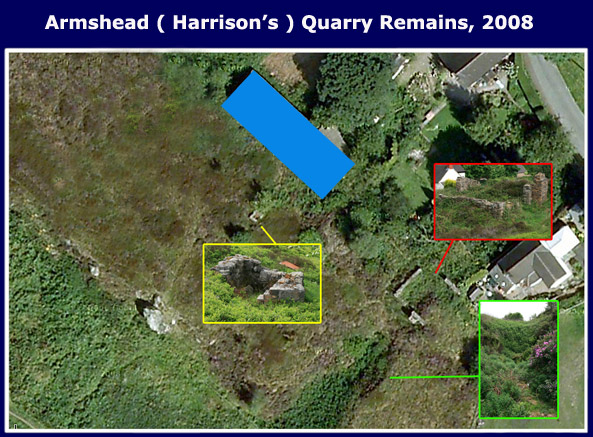
Blue Border - The Slabbing Shed - This is the remains of the 'Slabbing Shed' where the sandstone was compacted and laid out to dry in the slab moulds.
Yellow Border - The Powder Shed - The remains of the small hut where the sticks of dynamite used for blasting would have been kept.
Green Border - The Gully - Although mostly filled in now, you can still see the path of the gully that the trucks were pulled up from the quarry to the drying and grinding shed.
Red Border - The Drying Shed - This is where the sandstone from the quarry was dried out and ground into sand. At the rear of the shed was a loading bay, where the sand would be shovelled into the back of waiting delivery wagons.
Memories of the Quarry (Submitted by Mr. Tony McNicol)
My father used to be the Forman at the quarry along Armshead, and when I was a lad I used to go along sometimes during the school holidays to help the men to quarry the stone.
It was ‘blasted’ out from the rock face, (whilst they were ‘blasting’ a man had to go onto Armshead Rd, & stop the traffic because small pieces of rock would sometimes land on the rd). After it had been blasted out the stone was loaded into small railway trucks, which were then hauled up a ‘gully’ from the quarry by a steel rope connected to a ‘winch engine’ into the ‘drying shed’ at the top of the slope.
The stone was then piled onto some very large - long metal plates, which had a fire underneath them & then left there until it was dry. It was then put into a machine with large metal rollers which crushed it into very small stones, then into another machine of the same kind which crushed it into sand.
The sand was then shovelled into a storage bay until a lorry came to collect it, the lorry reversed right up to the storage bay, then it was shovelled onto the back of the lorry (the storage bay was situated higher than the backs of the lorries, so the men had to shovel the sand ‘down’ onto the back of the lorry), then it was taken to Harrison’s in Lichfield St. Hanley for making pottery.
There was also another very long shed running east to west that was used for the making of flagstones & concrete ornaments, (a few of which I still have around the yard), & a very small ‘hut’ near to the big rock & away from any of the buildings that was used for the storing of the dynamite for blasting.
The quarry was closed down around 1955.
The quarry has been filled in with refuge, & then levelled out so that you cannot tell that there was ever a quarry there now. I estimate that the height from the top of the quarry to the bottom would be approximately 30 to 40ft. I know that there are three old cars buried there that a relation of mine dumped whilst the Council were dumping their refuge there, a MK2 Jaguar, a Rover P4, & a Standard Pennant.
